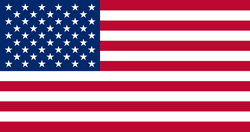| |
Proper Display of the US Flag
Also known as "Flag Etiquette"
Excerpted from Title 4, Chapter 1, of the United States Code (4 U.S.C. § 1 et seq)
|
|
1. OVER A STREET - When the flag is
displayed over the middle of the street, it should be suspended vertically
with the union (blue field of stars) to the north over an east-west street, or to the east over a
north-south street.
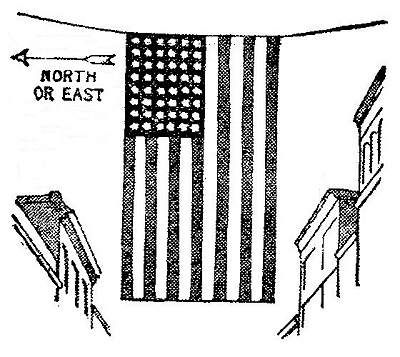
2. CROSSED STAFFS AGAINST A WALL - The US flag, when displayed with another flag against
a wall from crossed staffs, should be on the flag's own right
(that is... to the viewer's left), and its staff should be in
front of the staff of the other flag.

Yes |

NO |
3. HALF-STAFF - The flag, when
flown at half-staff, should be first hoisted to the peak for an instant and
then lowered to the half-staff position. The flag should be again raised to
the peak before it is lowered for the day. By "half-staff" is meant lowering
the flag to one-half the distance between the top and bottom of the staff.
Crepe streamers may be affixed to spear heads or flagstaffs in a parade only
by order of the President of the United States.
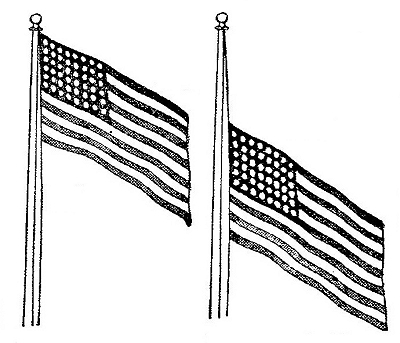
4. OTHER FLAGS ON SAME HALYARD - When flags of
states, cities, or localities, or pennants of societies are flown on the
same halyard with the US flag, the US flag should always be
at the peak. When the flags are flown from adjacent staffs, the US flag should be hoisted first and lowered last. No such flag or
pennant may be placed above the US flag, or to the right of
the US flag.
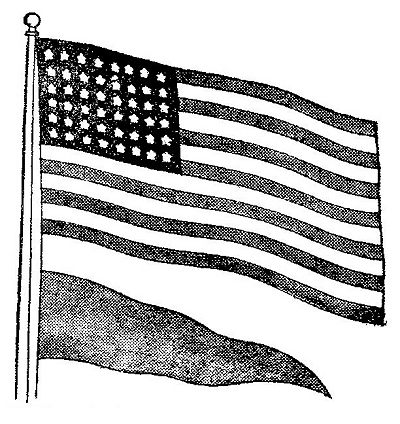
5. FROM A BUILDING - When the flag
is suspended over a sidewalk from a rope extending from a house (or other building) to a pole at
the edge of the sidewalk, the flag should be hoisted out, union (blue field of stars) first, from
the building.
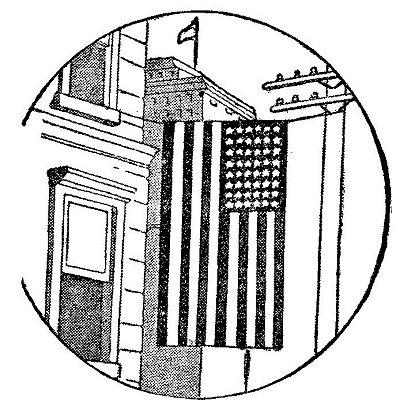
6. AT PEAK OF STAFF - When the US flag is displayed from a staff projecting horizontally or at
an angle from the window sill, balcony, or front of a building, the union (blue field of stars) of
the flag should be placed at the peak of the staff, unless the flag is at
half-staff.
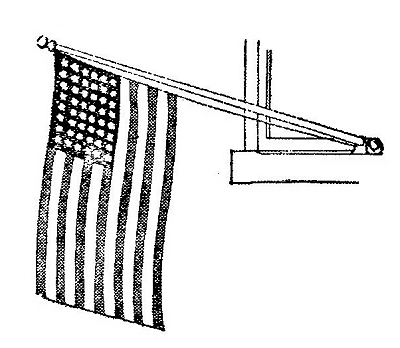
7. CASKET - When the flag
is used to cover a casket, the union (blue field of stars) is at the
head and over the left shoulder (of the deceased). The flag should not be lowered into the
grave or allowed to touch the ground.
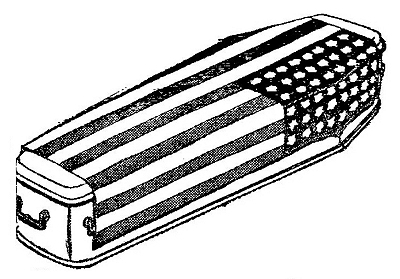
8. VERTICAL or HORIZONTAL (This and #12 are the most common errors when displaying the US flag.) - When the flag
is displayed in a manner other than by being flown from a staff, it should
be displayed flat, whether indoors or out. When displayed either
horizontally or vertically against a wall, the union (blue field of stars) should be uppermost and
to the flag's own right, that is, to the observer's left. When displayed in
a window, it should be displayed in the same way, that is with the union (blue field of stars) to the left of the observer in the street. When festoons,
rosettes or drapings are desired, bunting of blue, white and red should be
used, but never the flag.
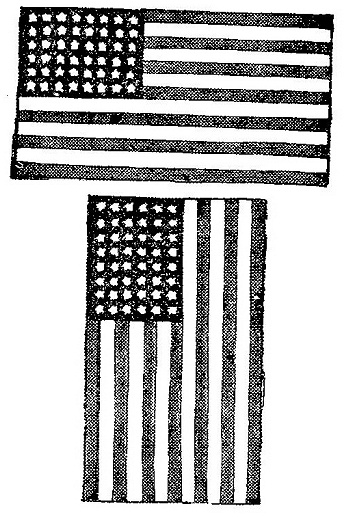
Yes |
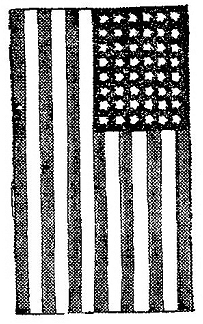
NO |
9. PROCESSION or PARADE - The flag,
when carried in a procession with another flag, or flags, should be either
on the marching right; that is, the flag's own right, or, if there is a line
of other flags, in front of the center of that line.
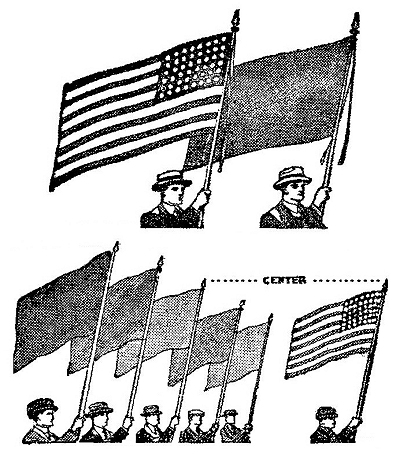
10.
GROUP OF FLAGS - The US flag should be at the center and at the
highest point of the group when a number of flags of states or localities or
pennants of societies are grouped and displayed from staffs.

11. OTHER NATIONS - When flags of
two or more nations are displayed, they are to be flown from separate staffs
of the same height. The flags should be of approximately equal size.
International usage forbids the display of the flag of one nation above that
of another nation in time of peace.
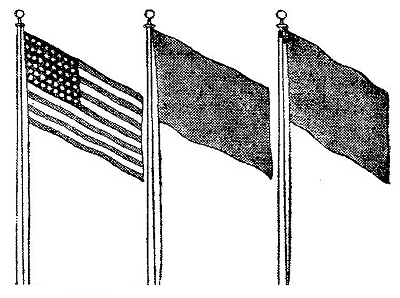
12. AT PODIUM or ON STAGE (This and #8 are the most common errors when displaying the US flag.) - When
displayed from a staff in a church or public auditorium, the US flag should hold the position of superior prominence, in
advance of the audience, and in the position of honor at the clergyman's or
speaker's right as he/she faces the audience (to your left as you look at the speaker). Any other flag so displayed should
be placed on the left of the clergyman or speaker (to the right as you look at it from the
audience).
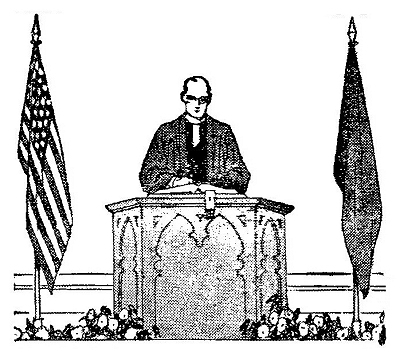
Yes |
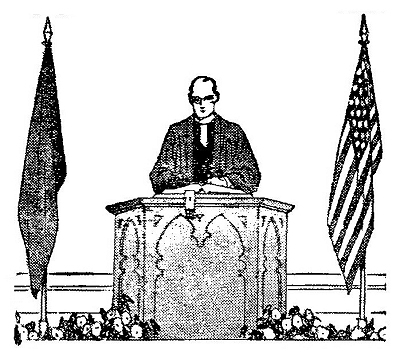
NO |
MOVING OBJECTS - In recent years, it has become increasingly popular to display the US flag on uniforms, trucks, jets, and other moving objects. In these situations, display the flag as if it were flying from a staff being held vertically and walked down a street in a parade. For example, if the horizontal US flag is displayed on the person's left sleeve or left side, use the traditional horizontal flag with the blue in the upper left. But if the flag is displayed on the right sleeve or right side of the person's uniform, the horizontal US flag would have the blue in the upper right, as if the flag were flying from a staff. If the flag appears on the person's chest, the standard horizontal flag would be used (blue in the upper left).
On a jet or other moving vehicle, the horizontal US flag on the port (left) side of the aircraft would use the traditional flag with the blue in the upper left. But on the starboard (right) side of the aircraft, the horizontal US flag would have the blue in the upper right, as if the flag were flying from a staff. This seems to be backwards and perhaps awkward to some, but simply think of it as a staff from which the flag is flying (moving).
Below are excellent examples of how the US flag is correctly displayed on moving objects. The blue is in the upper right when the flag is displayed on the RIGHT side of the moving object, as if the flag were flying in the breeze from a staff in a parade.



Vintage black-and-white artwork courtesy "The Flag Code," a 1924 brochure by the National Society Daughters of the American Revolution.
Miscellaneous Common Questions
The American Legion, 2-22-2021. Modified for clarity.
- May a flag that has covered a casket be displayed after its original use? Yes. There are no provisions in the Flag Code to suggest otherwise. It would be a fitting tribute to the memory of the deceased veteran and his or her service to a grateful nation if the casket flag is displayed.
- May the US flag be displayed in inclement weather? Yes and no. The flag should not be displayed on days when the weather is inclement, with the exception of an all-weather (nylon or other non-absorbent material) flag. However, most flags are made of all-weather materials.
- What is the significance of displaying the flag at half-staff? This gesture is a sign to indicate the nation mourns the death of an individual(s), such as death of the president or former president, vice president, Supreme Court justice, member of Congress, secretary of an executive or military department, etc. Only the president or a state governor may order the flag to be displayed at half-staff. The honor and reverence accorded this solemn act is quickly becoming eroded by those individuals and agencies that display the flag at half-staff on inappropriate occasions without proper authority to do so.
- When the flag is not flown from a staff, how should it be displayed? It should be displayed vertically, whether indoors or out, and suspended so that its folds fall free as though the flag were staffed. The stripes may be displayed either horizontally or vertically against a wall, and the union should be uppermost and to the flag's own right (that is, to the observer's left). When displayed in a window of a home or a place of business, the flag should be displayed in the same way (that is, with the union or blue field to the left of the observer in the street).
- How are unserviceable flags destroyed? The Flag Code suggests that when a flag has served its useful purpose, "it should be destroyed, preferably by burning." For individual citizens, this should be done discreetly so the act of destruction is not perceived as a protest or desecration. Many American Legion posts conduct disposal of unserviceable flag ceremonies on June 14, Flag Day. Such ceremonies are particularly dignified and solemn occasions for the retirement of unserviceable flags.
- May the flag be washed or dry-cleaned? Yes. No provisions of the Flag Code prohibit such care. The decision to wash or dry-clean would depend on the material.
- Are you required to destroy the flag if it touches the ground? No. The Flag Code states that the flag should not touch anything beneath it, including the ground. This is stated to indicate that care should be exercised in the handling of the flag, to protect it from becoming soiled or damaged. You are not required to destroy the flag when this happens. As long as the flag remains suitable for display, even if washing or dry-cleaning is required, you may continue to display the flag as a symbol of our great country.
- What is the proper method for folding the flag? The Flag Code does not require any specific method. However, a tradition of folding has developed over time that produces a triangular-shaped form, like that of a three-corner hat with only the blue union showing.
- May a person, other than a veteran, have his or her casket draped with the flag of the United States? Yes. Although this honor is usually reserved for veterans or highly regarded state and national figures, the Flag Code does not prohibit this use.
- What is the significance of the gold fringe seen on some US flags? Records indicate that fringe was first used on the flag as early as 1835. It was not until 1895 it was officially added to the national flag for all Army regiments. For civilian use, fringe is not required as an integral part of the flag, nor can its use be said to constitute an unauthorized addition to the design prescribed by statute. Fringe is used as an honorable enrichment only.
- What is meant by the flag's own right? The "right" as the position of honor developed from the time when the right hand was the "weapon hand" or "point of danger." The right hand, raised without a weapon, was a sign of peace. The right hand, to any observer, is the observer's left. Therefore, as used in the Flag Code, the flag and/or blue field is displayed to the observer's left, which is the flag's "own right."
- Is it proper to fly the US flag at night? Yes with proper illumination. The Flag Code states it is the universal custom to display the flag only from sunrise to sunset on buildings and on stationary flag staffs in the open. However, when a patriotic effect is desired, the flag may be displayed 24 hours a day if properly illuminated during the hours of darkness. The American Legion interprets "proper illumination" as a light specifically placed to illuminate the flag (preferred) or having a light source sufficient to illuminate the flag so it is recognizable as such by the casual observer.
- What should be the position of the flag when displayed from a staff in a church, public auditorium or other public meeting place, whether indoors or outdoors, on platform, or on the floor at ground level? When used on a speaker's platform, the flag, if displayed flat, should be displayed above and behind the speaker. When displayed from a staff in a church, public auditorium or meeting place, the flag should hold the position of superior prominence, in advance of the audience, and in the position of honor at the clergyman's or speaker's right as he faces the audience. Prior to the Flag Code changes in 1976, the display procedure was somewhat different. Now, the staffed flag should always be placed to the right of the speaker (observer's left) without regard to a platform or floor level.
- What are the penalties for the physical desecration of the flag? There are currently no penalties for the physical desecration of the flag. The American Legion and other members of the Citizens Flag Alliance continue working toward securing a constitutional amendment to protect the flag from physical desecration.
